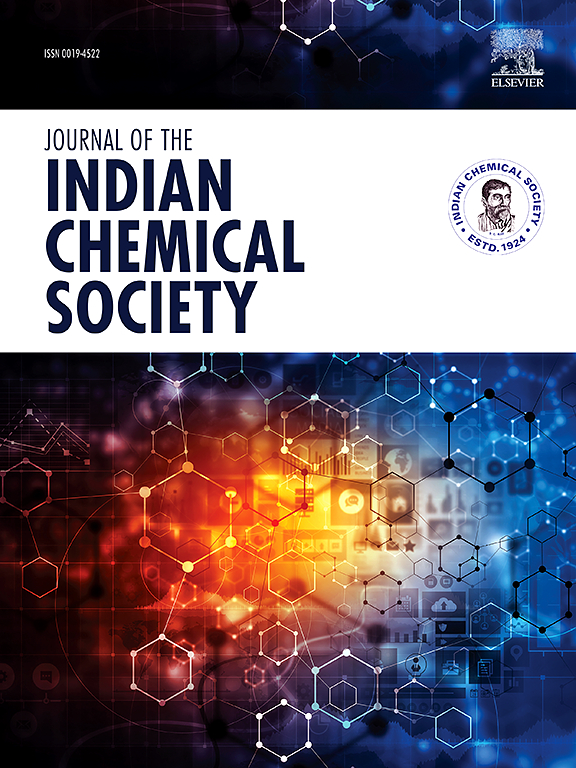Tailoring dopant concentrations in bismuth oxide nanoparticles for enhanced solar-driven photocatalytic wastewater remediation
IF 3.2
4区 化学
Q2 CHEMISTRY, MULTIDISCIPLINARY
引用次数: 0
Abstract
Pure and Mn-doped bismuth oxide (Bi2O3:Mn) nanoparticles were prepared by the low-temperature solution combustion method with urea as fuel, followed by calcination at 600 °C. The Bi2O3 was analyzed using X-ray diffraction method to find out the tetragonal phase of single Bi2O3 and no impurity, but UV–Vis spectroscopy indicates a hypsochromic (blue) shift in the absorption edge to 341 from 354 when doped with Mn. Bandgap decreased from 3.63 eV (Bi2O3) to 3.5 eV (Mn-doped), which means improved visible-light absorption through Mn-induced defect states. Application of simulated sunlight led to the photocatalytic degradation of methylene blue (MB), over which its Mn-doped Bi2O3 sample attained the MB removal of 96 % within 2 h, whereas undoped Bi2O3 (73 % degradation). This enhancement is due to the fact that Mn participates in the suppression of electron-hole recombination and the facilitation of charge separation, confirmed by decreased photoluminescence intensity and increased rate of reaction. Morphological studies (SEM) proved the uniformity of the nanoparticles, whilst the EDAX confirmed the incorporation of Mn. Such findings show that Mn doping is a good way of fine-tuning Bi2O3 to a structure that is more suitable for use in environmental remediation. The scalable synthesis technique and enhanced photocatalytic activity of Mn-doped Bi2O3 NPs make them a potential material for dye-contaminated wastewater remediation using natural sunlight, overcoming the key issues of sustainable pollution abatement and photocatalysis-driven chemical processes.
调整氧化铋纳米颗粒中掺杂剂浓度以增强太阳能驱动的光催化废水修复
以尿素为燃料,采用低温溶液燃烧法,在600℃下煅烧,制备了纯净的Mn掺杂氧化铋(Bi2O3:Mn)纳米颗粒。用x射线衍射法对Bi2O3进行了分析,发现了单一Bi2O3的四方相,没有杂质,但UV-Vis光谱表明,当掺杂Mn时,吸收边从354移到了341。带隙从3.63 eV (Bi2O3)减小到3.5 eV (mn掺杂),这意味着通过mn诱导的缺陷态提高了可见光吸收。模拟阳光的应用导致了亚甲基蓝(MB)的光催化降解,其中mn掺杂Bi2O3样品在2小时内达到96%的MB去除率,而未掺杂Bi2O3样品的降解率为73%。这种增强是由于Mn参与了抑制电子-空穴复合和促进电荷分离的作用,这可以通过光致发光强度的降低和反应速率的提高来证实。形貌研究(SEM)证实了纳米颗粒的均匀性,而EDAX证实了Mn的掺入。这些发现表明,Mn掺杂是一种将Bi2O3微调成更适合用于环境修复的结构的好方法。mn掺杂Bi2O3 NPs的可扩展合成技术和增强的光催化活性使其成为利用自然阳光修复染料污染废水的潜在材料,克服了可持续污染减排和光催化驱动的化学过程的关键问题。
本文章由计算机程序翻译,如有差异,请以英文原文为准。
求助全文
约1分钟内获得全文
求助全文
来源期刊
CiteScore
3.50
自引率
7.70%
发文量
492
审稿时长
3-8 weeks
期刊介绍:
The Journal of the Indian Chemical Society publishes original, fundamental, theorical, experimental research work of highest quality in all areas of chemistry, biochemistry, medicinal chemistry, electrochemistry, agrochemistry, chemical engineering and technology, food chemistry, environmental chemistry, etc.

 求助内容:
求助内容: 应助结果提醒方式:
应助结果提醒方式:


